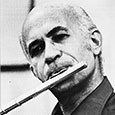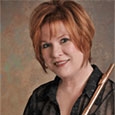.jpg)
A few months before Murray Panitz died from an aneurism on April 13, 1989 at the age of 63, he announced his retirement, effective in September 1990, as principal flutist of the Philadelphia Orchestra. His death was a shock to the musical community and violist Sidney Curtis said he had never seen the Philadelphia Orchestra so demoralized. At a memorial service at the Academy of Music family, friends, and colleagues spoke of Panitz’ warmth, generosity, wit, and magnificent playing. He endeared himself to others not only with his sense of humor, but also with his effortless musical ability.
One month before his death Panitz spoke lightheartedly about his retirement, saying he planned to move to Louisville, Kentucky where he would enjoy teaching, giving master classes, and gardening. "I’ll have more time to myself. I might even practice."
Reminiscing about his early music study Panitz said, "When I was only five years old, I went to the Settlement Music School in New York but was too young to study the piano. I was placed in a boys’ chorus where I sang soprano. I appeared as a soloist in two film shorts with two singers from the Metropolitan Opera: baritone Lawrence Tibbett and tenor Richard Crooks. The only thing I remember about my experience is that each singer gave me a box of candy, but my father and brother devoured them before I could."
Panitz began to study the piano when he was seven years old. He was a talented student with an excellent memory, and could finish a book in a week. Panitz later entered the High School of Music and Art, now Performing Arts High School, in New York City. Two of his fellow students were pianist Myrna Rubinstein whom he later married, and bassoonist Bernard Garfield, who became the principal bassoonist in the Philadelphia Orchestra.
The school required each music student to study a second instrument and a teacher told him he would play the flute. "I didn’t even know what a flute was, and wasn’t interested in it. One teacher, a clarinet player, taught me so many wrong fingerings I’m surprised I could get a sound out of the instrument. When I took my first real lesson, however, I was hooked."
Panitz studied in New York with Harry Moskowitz and William Heim, a former piccolo player in the New York Philharmonic. "My claim to fame in high school was that future Miss America Bess Myerson was in my class and she also played the flute, sitting next to me in the band. Frequently I heard, ‘Sonny, move over’ while they took her picture."
When he was only 16, Panitz entered the Eastman School of Music. The flutists who attended Eastman at the same time included Doriot Anthony Dwyer, Robert Willoughby, Walfrid Kujala, and Roger Stevens. They all studied with Joseph Mariano. "He was one of the world’s greatest flutists. Most things came easily to me so that I didn’t have to work too hard. Who knows? I could have been a success if I had practiced."
During Panitz’ freshman year, Mariano encouraged him to audition for the Chicago Symphony. "I could play a lot of notes, but I only knew a few lines of orchestral pieces from an excerpt book. At the audition the conductor pointed to other passages in the music, but I didn’t have any idea how they should be played. From that point on I never wanted to see an excerpt, only a complete part."
After graduating from Eastman, Panitz was named principal flutist of the National Symphony. A short time later he was drafted into the U.S. Air Force and stationed in Washington D.C. where he played in the Air Force Band.
"The concert master of the orchestra suggested that I play in the orchestra, but the commanding officer disliked me because I was not a career man. He said, ‘I wouldn’t use Murray Panitz if he were the first flute in the Philadelphia Orchestra.’"
When Panitz left the Air Force, he moved to New York rather than return to the National Symphony. He studied at the Manhattan School of Music where he earned a graduate degree in music theory. Eventually he became a successful free-lance flutist in New York. He enjoyed playing first flute in the Symphony of the Air, the Little Orchestra Society of New York, the New York City Ballet, as well as for shows and television productions such as The Producer’s Showcase, The Defenders; and The Bell Telephone Hour.
"My first break in New York was when Albert Goltzer, an oboist who later joined the New York Philharmonic, was walking down the street with one of the biggest contractors in town. We stopped and greeted each other. The contractor needed a flutist and had exhausted his entire list of flute players. Goltzer said, ‘Why don’t you use Murray Panitz?’ He did.
"Playing in New York was fun because there were excellent musicians. At that time, the option to take a symphonic job was not ideal because the salary was poor. When I joined the Philadelphia Orchestra, we played a 30-week season, maybe 6 weeks in the summer, and the pay was around $6500 a year. Most of the players had to sell ice cream or used cars in the off season to make ends meet. I took a pay cut to join the orchestra, but this was my life’s dream."
Conductor Eugene Ormandy invited Panitz to audition for the Philadelphia Orchestra in 1961 along with 13 other flutists. "I played for about 20 minutes. Afterwards, Ormandy asked me to come into his office, and he offered me the job. One of my closest friends told me I was crazy to leave New York to go to Philadelphia. He told me I would be giving up 50 tax withholding slips for one.
"As soon as I arrived in Philadelphia the orchestra went on strike for six weeks. Never being a saver but rather a spender, I found it was very difficult to make ends meet. People were still calling me for jobs in New York, but I had to be in Philadelphia when they settled the contract negotiations.
"During the strike, the orchestra performed a memorial concert for Dag Hammarskjold at the U.N., and we played Beethoven’s 9th. This was the first time I played with the orchestra and Eugene Ormandy. I have to thank my bassoonist friend Bernie Garfield for warning me not to play with the conductor’s beat, especially because I was used to television where one needs to react immediately to the beat. This orchestra under Ormandy had a delayed beat, but it was incredible how accurately everyone played. The attacks were fantastically together. I could see Ormandy’s hand go down and then, somehow, everyone came in at the right time. It was scary. The concert went well, and I didn’t get a pioneer medal, as we said in those days, for making an early attack.
"Once when we were on tour, we tried to get Ormandy to make us play with the beat. After our concertmaster, Anshel Brusilow, had spoken to the maestro about the idea, Ormandy called me backstage before the concert. ‘You’re the concertmaster of the winds,’ he said. ‘From now on we play with the beat.’
"I returned to the stage and gave the winds the message. The first half of the concert was chaotic. At intermission, I was again summoned by an upset and irate Ormandy. Glaring at Brusilow, he said, ‘It’s all your fault. We go back to the way we always play.’"
When Panitz won the position of principal flute in the Philadelphia Orchestra, the playing of former principal flutist William Kincaid was a vivid memory for Philadelphia audiences. "Following a legend like Kincaid was difficult. He was a great player, and, besides, he had much more hair."
Soon after he took the job in the Philadelphia Orchestra, Panitz realized that it would be important for him to establish his own musical personality. "A few weeks before one of the first recording sessions I did with orchestra, Ormandy asked me if I had ever played Scheherazade. ‘No, sir,’ I replied.
"’Do you know that we’re going to record it?’ ‘That’s nice,’ I said.
"’Have you ever heard our orchestra play it?’ ‘No.’
"’Have you ever heard Kincaid do the solos?’ ‘No.’ I could see that Ormandy was getting edgy. ‘Well, I’ll let you have another recording of Scheherazade we made, and you can listen to it.’ ‘Thank you very much, Maestro. I’ll listen to it as soon as the recording session is over.’
"I had decided that as great as Kincaid was, I was not going to be his mimic. Either I was going to stay in Philadelphia under my own name or leave."
Although Panitz wanted to express his own musical ideas, he admired Kincaid and acknowledged Kincaid’s influence on American flute playing.
"Basically it’s a concept of sound. Kincaid was able to produce a big sound by using more embouchure, unlike the Quantz method of covering more of the hole while ascending into the upper register. I don’t enjoy a trumpet-like sound in the low register and a shrill piccolo sound in the upper register. I want consistent sound in all registers. A more edgy sound is possible in the low register, for example, as an alternate color.
"I use vibrato as a variation in tone color. I use a range of depths and speeds to help me interpret the music. That doesn’t mean everyone will agree with my interpretation, but I have to work within my natural ability. A flutist can’t play the Afternoon of a Faun solo and the Brahms 4th solo with the same vibrato. If the vibrato is too fast for the Debussy solo, it sounds like the Faun is neurotic and in need of a psychiatrist; rather, the sound should be placid and warm, not edgy. On the other hand, Brahms’ 4th needs an electric, exciting tone because that is what the music demands.
"It’s not sufficient to have a beautiful sound. I like to hear a flutist interpret with a full range of dynamics and a controlled sound. A musician should know how to interpret music, giving it direction and flow, adding rubato to give the music a human element. We are not metronomical instruments. If you put a metronome to any recorded piece of music, you won’t be able to keep it with the beat for more than a few measures.
"The push today is towards robotlike playing, perfect technique, perfect rhythm, without saying much. Music is an emotional and aural response. If given a choice I would rather have the emotional response. I tire of a beautiful sound that says nothing."






